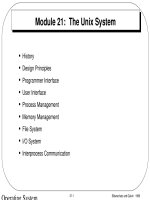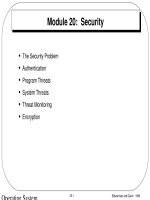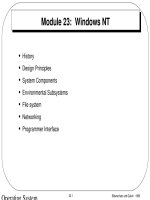Lecture Operating system concepts - Module 17
Bạn đang xem bản rút gọn của tài liệu. Xem và tải ngay bản đầy đủ của tài liệu tại đây (298.77 KB, 58 trang )
Module 17: Distributed-File Systems
•
•
•
•
•
•
Background
Naming and Transparency
Remote File Access
Stateful versus Stateless Service
File Replication
Example Systems
17.1
Silberschatz, Galvin, and Gagne
1999
Background
•
Distributed file system (DFS) – a distributed implementation of
the classical time-sharing model of a file system, where
multiple users share files and storage resources.
•
•
A DFS manages set of dispersed storage devices
•
There is usually a correspondence between constituent storage
spaces and sets of files.
Overall storage space managed by a DFS is composed of
different, remotely located, smaller storage spaces.
17.2
Silberschatz, Galvin, and Gagne
1999
DFS Structure
•
Service – software entity running on one or more machines and
providing a particular type of function to a priori unknown
clients.
•
•
Server – service software running on a single machine.
•
A client interface for a file service is formed by a set of primitive
file operations (create, delete, read, write).
•
Client interface of a DFS should be transparent, i.e., not
distinguish between local and remote files.
Client – process that can invoke a service using a set of
operations that forms its client interface.
17.3
Silberschatz, Galvin, and Gagne
1999
Naming and Transparency
•
•
Naming – mapping between logical and physical objects.
•
A transparent DFS hides the location where in the network the
file is stored.
•
For a file being replicated in several sites, the mapping returns
a set of the locations of this file’s replicas; both the existence of
multiple copies and their location are hidden.
Multilevel mapping – abstraction of a file that hides the details
of how and where on the disk the file is actually stored.
17.4
Silberschatz, Galvin, and Gagne
1999
Naming Structures
•
Location transparency – file name does not reveal the file’s
physical storage location.
– File name still denotes a specific, although hidden, set of
physical disk blocks.
– Convenient way to share data.
– Can expose correspondence between component units
and machines.
•
Location independence – file name does not need to be
changed when the file’s physical storage location changes.
– Better file abstraction.
– Promotes sharing the storage space itself.
– Separates the naming hierarchy form the storage-devices
hierarchy.
17.5
Silberschatz, Galvin, and Gagne
1999
Naming Schemes — Three Main Approaches
•
Files named by combination of their host name and local name;
guarantees a unique systemwide name.
•
Attach remote directories to local directories, giving the
appearance of a coherent directory tree; only previously
mounted remote directories can be accessed transparently
•
Total integration of the component file systems.
– A single global name structure spans all the files in the
system.
– If a server is unavailable, some arbitrary set of directories
on different machines also becomes unavailable. .
17.6
Silberschatz, Galvin, and Gagne
1999
Remote File Access
•
Reduce network traffic by retaining recently accessed disk
blocks in a cache, so that repeated accesses to the same
information can be handled locally..
– If needed data not already cached, a copy of data is
brought from the server to the user.
– Accesses are performed on the cached copy.
– Files identified with one master copy residing at the server
machine, but copies of (parts of) the file ar scattered in
different caches.
– Cache-consistency problem – keeping the cached copies
consistent with the master file.
17.7
Silberschatz, Galvin, and Gagne
1999
Location – Disk Caches vs. Main Memory Cache
•
Advantages of disk caches
– More reliable.
– Cached data kept on disk are still there during recovery
and don’t need to be fetched again.
•
Advantages of main-memory caches:
– Permit workstations to be diskless.
– Data can be accessed more quickly.
– Performance speedup in bigger memories.
– Server caches (used to speed up disk I/O) are in main
memory regardless of where user caches are located;
using main-memory caches on the user machine permits
a single caching mechanism for servers and users.
17.8
Silberschatz, Galvin, and Gagne
1999
Cache Update Policy
•
Write-through – write data through to disk as soon as they are
placed on any cache. Reliable, but poor performance.
•
Delayed-write – modifications written to the cache and then
written through to the server later. Write accesses complete
quickly; some data may be overwritten before they are written
back, and so need never be written at all.
– Poor reliability; unwritten data will be lost whenever a user
machine crashes.
– Variation – scan cache at regular intervals and flush
blocks that have been modified since the last scan.
– Variation – write-on-close, writes data back to the server
when the file is closed. Best for files that are open for long
periods and frequently modified.
17.9
Silberschatz, Galvin, and Gagne
1999
Consistency
•
Is locally cached copy of the data consistent with the master
copy?
•
Client-initiated approach
– Client initiates a validity check.
– Server checks whether the local data are consistent with
the master copy.
•
Server-initiated approach
– Server records, for each client, the (parts of) files it
caches.
– When server detects a potential inconsistency, it must
react.
17.10
Silberschatz, Galvin, and Gagne
1999
Comparing Caching and Remote Service
•
In caching, many remote accesses handled efficiently by the
local cache; most remote accesses will be served as fast as
local ones.
•
Servers are contracted only occasionally in caching (rather than
for each access).
– Reduces server load and network traffic.
– Enhances potential for scalability.
•
Remote server method handles every remote access across
the network; penalty in network traffic, server load, and
performance.
•
Total network overhead in transmitting big chunks of data
(caching) is lower than a series of responses to specific
requests (remote-service).
17.11
Silberschatz, Galvin, and Gagne
1999
Caching and Remote Service (Cont.)
•
Caching is superior in access patterns with infrequent writes.
With frequent writes, substantial overhead incurred to
overcome cache-consistency problem.
•
Benefit from caching when execution carried out on machines
with either local disks or large main memories.
•
Remote access on diskless, small-memory-capacity machines
should be done through remote-service method.
•
In caching, the lower intermachine interface is different form the
upper user interface.
•
In remote-service, the intermachine interface mirrors the local
user-file-system interface.
17.12
Silberschatz, Galvin, and Gagne
1999
Stateful File Service
•
Mechanism.
– Client opens a file.
– Server fetches information about the file from its disk,
stores it in its memory, and gives the client a connection
identifier unique to the client and the open file.
– Identifier is used for subsequent accesses until the
session ends.
– Server must reclaim the main-memory space used by
clients who are no longer active.
•
Increased performance.
– Fewer disk accesses.
– Stateful server knows if a file was opened for sequential
access and can thus read ahead the next blocks.
17.13
Silberschatz, Galvin, and Gagne
1999
Stateless File Server
•
Avoids state information by making each request selfcontained.
•
•
Each request identifies the file and position in the file.
No need to establish and terminate a connection by open and
close operations.
17.14
Silberschatz, Galvin, and Gagne
1999
Distinctions Between Stateful & Stateless Service
•
Failure Recovery.
– A stateful server loses all its volatile state in a crash.
Restore state by recovery protocol based on a dialog
with clients, or abort operations that were underway
when the crash occurred.
Server needs to be aware of client failures in order to
reclaim space allocated to record the state of crashed
client proc������������������������������������������������������������������������������������������������������������������������������������������������������������������������������������������������������������������������������������������������������������������������������������������������������������������������������������������������������������������������������������������������������������������������������������������������������������������������������������������������������������������������������������������������������������������������������������������������������������������������������������������������������������������������������������������������������������������������������������������������������������������������������������������������������������������������������������������������������������������������������������������������������������������������������������������������������������������������������������������������������������������������������������������������������������������������������������������������������������������������������������������������������������������������������������������������������������������������������������������������������������������������������������������������������������������������������������������������������������������������������������������������������������������������������������������������������������������������������������������������������������������������������������������������������������������������������������������������������������������������������������������������������������������������������������������������������������������������������������������������������������������������������������������������������������������������������������������������������������������������������������������������������������������������������������������������������������������������������������������������������������������������������������������������������������������������������������������������������������������������������������������������������������������������������������������������������������������������������������������������������������������������������������������������������������������������������������������������������������������������������������������������������������������������������������������������������������������������������������������������������������������������������������������������������������������������������������������������������������������������������������������������������������������������������������������������������������������������������������������������������������������������������������������������������������������������������������������������������������������������������������������������������������������������������������������������������������������������������������������������������������������������������������������������������������������������������������������������������������������������������������������������������������������������������������������������������������������������������������������������������������������������������������������������������������������������������������������������������������������������������������������������������������������������������������������������������������������������������������������������������������������������������������������������������������������������������������������������������������������������������������������������������������������������������������������������������������������������������������������������������������������������������������������������������������������������������������������������������������������������������������������������������������������������������������������������������������������������������������������������������������������������������������������������������������������������������������������������������������������������������������������������������������������������������������������������������������������������������������������������������������������������������������������������������������������������������������������������������������������������������������������������������������������������������������������������������������������������������������������������������������������������������������������������������������������������������������������������������������������������������������������������������������������������������������������������������������������������������������������������������������������������������������������������������������������������������������������������������������������������������������������������������������������������������������������������������������������������������������������������������������������������������������������������������������������������������������������������������������������������������������������������������������������������������������������������������������������������������������������������������������������������������������������������������������������������������������������������������������������������������������������������������������������������������������������������������������������������������������������������������������������������������������������������������������������������������������������������������������������������������������������������������������������������������������������������������������������������������������������������������������������������������������������������������������������������������������������������������������������������������������������������������������������������������������������������������������������������������������������������������������������������������������������������������������������������������������������������������������������������������������������������������������������������������������������������������������������������������������������������������������������������������������������������������������������������������������������������������������������������������������������������������������������������������������������������������������������������������������������������������������������������������������������������������������������������������������������������������������������������������������������������������������������������������������������������������������������������������������������������������������������������������������������������������������������������������������������������������������������������������������������������������������������������������������������������������������������������������������������������������������������������������������������������������������������������������������������������������������������������������������������������������������������������������������������������������������������������������������������������������������������������������������������������������������������������������������������������������������������������������������������������������������������������������������������������������������������������������������������������������������������������������������������������������������������������������������������������������������������������������������������������������������������������������������������������������������������������������������������������������������������������������������������������������������������������������������������������������������������������������������������������������������������������������������������������������������������������������������������������������������������������������������������������������������������������������������������������������������������������������������������������������������������������������������������������������������������������������������������������������������������������������������������������������������������������������������������������������������������������������������������������������������������������������������������������������������������������������������������������������������������������������������������������������������������������������������������������������������������������������������������������������������������������������������������������������������������������������������������������������������������������������������������������������������������������������������������������������������������������������������������������������������������������������������������������������������������������������������������������������������������������������������������������������������������������������������������������������������������������������������������������������������������������������������������������������������������������������������������������������������������������������������������������������������������������������������������������������������������������������������������������������������������������������������������������������������������������������������������������������������������������������������������������������������������������������������������������������������������������������������������������������������������������������������������������������������������������������������������������������������������������������������������������������������������������������������������������������������������������������������������������������������������������������������������������������������������������������������������������������������������������������������������������������������������������������������������������������������������������������������������������������������������������������������������������������������������������������������������������������������������������������������������������������������������������������������������������������������������������������������������������������������������������������������������������������������������������������������������������������������������������������������������������������������������������������������������������������������������������������������������������������������������������������������������������������������������������������������������������������������������������������������������������������������������������������������������������������������������������������������������������������������������������������������������������������������������������������������������������������������������������������������������������������������������������������������������������������������������������������������������������������������������������������������������������������������������������������������������������������������������������������������������������������������������������������������������������������������������������������������������������������������������������������������������������������������������������������������������������������������������������������������������������������������������������������������������������������������������������������������������������������������������������������������������������������������������������������������������������������������������������������������������������������������������������������������������������������������������������������������������������������������������������������������������������������������������������������������������������������������������������������������������������������������������������������������������������������������������������������������������������������������������������������������������������������������������������������������������������������������������������������������������������������������������������������������������������������������������������������������������������������������������������������������������������������������������������������������������������������������������������������������������������������������������������������������������������������������������������������������������������������������������������������������������������������������������������������������������������������������������������������������������������n (Cont.)
•
Venus manages two separate caches:
– one for status
– one for data
•
•
LRU algorithm used to keep each of them bounded in size
•
The data cache is resident on the local disk, but the UNIX I/O
buffering mechanism does some caching of the disk blocks in
memory that are transparent to Venus.
The status cache is kept in virtual memory to allow rapid
servicing of stat (file status returning) system calls.
17.40
Silberschatz, Galvin, and Gagne
1999
SPRITE
•
An experimental distributed OS under development at the Univ.
of California at Berkeley; part of the Spur project – design and
construction of a high-performance multiprocessor workstation.
•
Targets a configuration of large, fast disks on a few servers
handling storage for hundreds of diskless workstations which
are interconnected by LANs.
•
Because fiel caching is used, the large physical memories
compensate for the lack of local disks.
•
Interface similar to UNIX; file system appears as a single UNIX
tree encompassing all files and devices in the network, equally
and transparently accessible form every workstation.
•
Enforces consistency of shared files and emulates a single
time-sharing UNIX system in a distributed environment.
17.41
Silberschatz, Galvin, and Gagne
1999
SPRITE (Cont.)
•
Uses backing files to store data and stacks of running
processes, simplifying process migration and enabling flexibility
and sharing of the space allocated for swapping.
•
The virtual memory and file system share the same cache and
negotiate on how to divide it according to their conflicting
needs.
•
Sprite provides a mechanism for sharing an address space
between client processes on a single workstation (in UNIX, only
code can be shared among processes).
17.42
Silberschatz, Galvin, and Gagne
1999
SPRITE Prefix Tables
•
A single file system hierarchy composed of several subtrees
called domains (component units), with each server providing
storage for one or more domains.
•
Prefix table – a server map maintained by each machine to
map domains to servers.
•
Each entry in a prefix table corresponds to one of the domains.
It contains:
– the name of the topmost directory in the domain (prefix for
the domain).
– the network address of the server storing the domain.
– a numeric designator identifying the domain’s root
directory for the storing server.
•
The prefix mechanism ensures that the domain’s files can be
opened and accessed from any machine regardless of the
status of the servers of domains above the particular domain.
17.43
Silberschatz, Galvin, and Gagne
1999
SPRITE Prefix Tables (Cont.)
•
Lookup operation for an absolute path names:
– Client searches its prefix table for the longest prefix
matching the given file name.
– Client strips the matching prefix from the file name and
sends the remainder of the name to the selected server
along with the designator from the prefix-table entry.
– Server uses this designator to locate the root directory of
the domain, and then proceeds by usual UNIX path-name
translation for the remainder of the file name.
– If server succeeds in completing the translation, it replies
with a designator for the open file.
17.44
Silberschatz, Galvin, and Gagne
1999
Case Where Server Does Not Complete Lookup
•
Server encounters an absolute path name in a symbolic line.
Absolute path name returned to client, which looks up the new
name in its prefix table and initiates another lookup with a new
server.
•
If a path name ascends past the root of a domain, the server
returns the remainder of the path name to the client, which
combines the remainder with the prefix of the domain that was
just exited to form a new absolute path name.
•
If a path name descends into a new domain or if a root of a
domain is beneath a working directory and a file in that domain
is referred to with a relative path name, a remote link (a special
marker file) is placed to indicate domain boundaries. When a
server encounters a remote link, it returns the file name to the
client.
17.45
Silberschatz, Galvin, and Gagne
1999
Path-name Translation
17.46
Silberschatz, Galvin, and Gagne
1999
Incomplete Lookup (Cont.)
•
When a remote link is encountered by the server, it indicates
that the client lacks an entry for a domain — the domain whose
remote link was encountered.
•
To obtain the missing prefix information, a client boradcasts a
file name.
– broadcast – network message seen by all systems on the
network.
– The server storing that file responds with the prefix-table
entry for this file, including the string to use as a prefix, the
server’s address, and the descriptor corresponding to the
domain’s root.
– The client then can fill in the details in its prefix table.
17.47
Silberschatz, Galvin, and Gagne
1999
SPRITE Caching and Consistency
•
Capitalizing on the large main memories and advocating
diskless workstations, file caches are stored in memory,
instead of on local disks.
•
Caches are organized on a block (4K) basis, rather than on a
file basis.
•
Each block in the cache is virtually addressed by the file
designator and a block location within the file; enables clients to
create new blocks in the cache and to locate any block without
the file inode being brought from the server.
•
A delayed-write approach is used to handle file modification.
17.48
Silberschatz, Galvin, and Gagne
1999
SPRITE Caching and Consistency (Cont.)
•
Consistency of shared files enforced through version-number
scheme; a file’s version number is incremented whenever a file
is opened in write mode.
•
Notifying the servers whenever a file is opened or closed
prohibits performance optimizations such as name caching.
•
Servers are centralized control points for cache consistency;
they maintain state information about open files.
17.49
Silberschatz, Galvin, and Gagne
1999
LOCUS
•
Project at the Univ. of California at Los Angeles to build a fullscale distributed OS; upward-compatible with UNIX, but the
extensions are major and necessitate an entirely new kernel.
•
File system is a single tree-structure naming hierarchy which
covers all objects of all the machines in the system.
•
•
Locus names are fully transparent.
•
File replication increases availability for reading purposes in the
event of failures and partitions.
•
A primary-copy approach is adopted for modifications.
A Locus file may correspond to a set of copies distributed on
different sites.
17.50
Silberschatz, Galvin, and Gagne
1999









